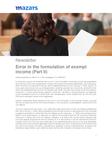
Error in the formulation of exempt income (Part II)
In a previous column we reviewed how an error in the formulation of exempt income has jeopardized the continuity of the river transportation industry with vessels and shallow draft boats. This is because, while numeral 8 of article 99 of the tax reform established that, as from January 1, 2018, and for 15 more years, the income from such transportation would be exempt from income tax, article 98 of the same law established that "as from the taxable year 2018, inclusive, the exempt income provided in numeral 2 (...) of this article will be subject to income tax". Number 2, referred to above, corresponds to the exempted income for shallow draft river transportation, which implies that, as from the year 2018 such exemption would not be applicable.
Another undesirable effect, product of the error in the formulation of the exempt income, occurred with the exempt income from the indemnification in life insurance, contemplated in article 223 of the Tax Statute.
The error arises when the reform, in its article 99, adds article 235-2 of the Tax Statute establishing that "As of January 1, 2018, without prejudice to the exempt income of natural persons, the only legal exceptions referred to in article 26 of the Tax Statute are the following (...)". Within the exempt income listed in such article below, no reference is made to the exempt income for life insurance indemnity referred to in Article 223 of the Tax Statute. Likewise, in its article 376, the tax reform indicates that such law repeals all provisions that are contrary to it. In this context, it can be inferred that since the exempt income from life insurance indemnity is not established within the list of the only admissible exempt income that would be applicable after the taxable year 2018, and because of the mention that any rule to the contrary should be understood as repealed, it can be understood that -at least for the beneficiary legal entities- such indemnity does not have the character of exempt income today.
Now, as the new article 235-2 of the Tax Statute establishes that such limitation is given "without prejudice of the exempt income of natural persons", the second part of the problem begins there, and it is how to treat such exempt income under the new system of taxation by schedules. Under the "non-labor income" category, which is where this type of income that is not expressly classified in any of the other categories is kept, the exempt income is limited to 10% of the result of subtracting the total income, minus the income not constituting income and the duly supported costs and expenses, which in any case cannot exceed 1,000 UVT's. Thus, if a person, who does not have any other type of non-labor income (and therefore no costs or expenses related to it) receives an indemnity for being the beneficiary of a life insurance policy equivalent to $1,000,000,000,000 pesos, he/she may only take as exempt income the amount of $31,859,000. The balance, i.e., $968,141,000 will be taxable at the marginal rate of 35% according to the table, since the treatment of such income flow cannot be treated as occasional gain (what some call the "sixth tax credit"), since the law specifically considers it as exempt income.
This example shows, once again, why the issuance of this type of rules must be preceded by a broad debate and study, and should not be simply the result of accelerated debates that end up affecting the competitiveness and even the very survival of entire industrial sectors, as is the case of river transportation with shallow draft vessels and planchons and life insurance.


